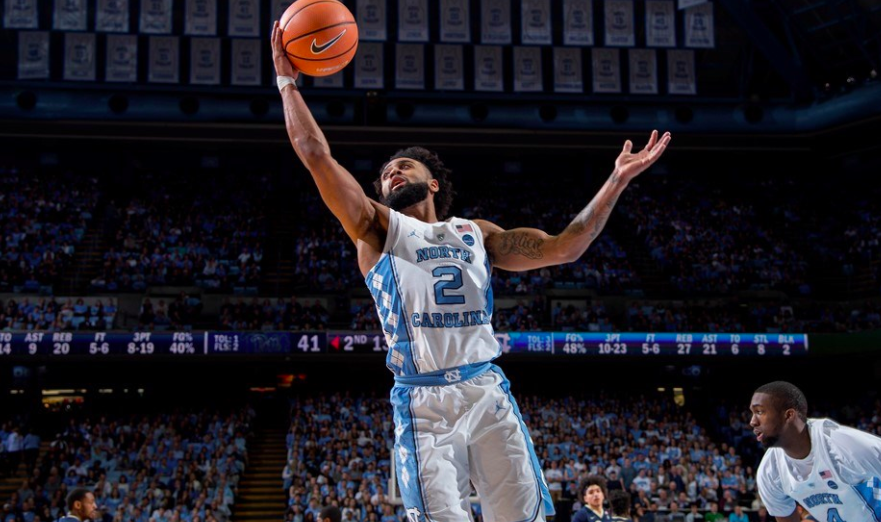For the first time in 2018, the Tobacco Road Rivalry takes the stage. On Thursday at 8 p.m., No. 9 Duke takes on No. 21 North Carolina in Chapel Hill. As always, there is far more at stake at the Dean E. Smith Center than another victory in the win column. The two schools are separated by eight miles and have combined for a total of 36 Final Fours and 11 national titles, as well as a wealth of NBA talent. North Carolina leads the overall series 135-110, though Duke is 18-12 since Roy Williams became the head coach of UNC in 2003.
During Williams’ time in Chapel Hill, the two teams’ play styles have typically contrasted in significant ways: North Carolina has hung its hat on strong post play and skilled big men, while Duke has relied on the outside shot for success. This year, however, the script has been flipped, as the Blue Devils have focused on pounding the ball inside, while the Tar Heels have a comparative advantage in perimeter play. Let’s take a deeper look at how each team scores its points.
North Carolina
After North Carolina won the 2017 National Title, it became apparent that the make-up of the 2018 team would vastly differ from vintage Tar Heel squads. Following the departure of (ACC Player of the Year) Justin Jackson, Kennedy Meeks, Isaiah Hicks, and Tony Bradley, Carolina was left with a bare cupboard on the interior. The only saving grace for the Heels was the return of Final Four Most Outstanding Player Joel Berry, who was joined by classmate Theo Pinson in anchoring the Carolina backcourt for 2018.
Enter Luke Maye. The former three-star recruit entered the annals of NCAA folklore following his game-winning jumper against Kentucky during last year’s Elite Eight (sorry, Cats fans), cementing his place in the hearts of Carolina fans. Despite Maye’s success as a reserve, few thought the Huntersville, N.C. native could feature as an offensive centerpiece. Maye has answered the critics, averaging a double-double with 18.3 points per game and 10.3 rebounds per game, as well as shooting 49 percent from beyond the arc. Maye is a tweener: while he rebounds like a big man three inches taller, he has built his game around turnaround mid-range jumpers and pop-out threes. This has left the Tar Heels without the traditional back-to-the-basket big man that nearly all of the program’s elite teams has featured.
North Carolina, facing a dearth of big men, has faced difficulty in running its vaunted primary offense, the secondary break. The secondary break pushes the tempo after a defensive rebound or made basket, with a focus on getting the ball inside to a rim-running big man. Back cuts and elevator screen plays are also prominent components of the offense, as the attention on the Carolina big men creates space for other players to get open shots and crash the glass. This year, however, the Heels feature only Maye as a legitimate post presence and, thus, have struggled to run their offense as efficiently as in years prior. The Tar Heels have even shifted to a small-ball lineup, starting 6-8 Cameron Johnson at the 4 slot. Combine the non-standard lineup with a subpar offensive season from Berry, who is shooting just 39 percent from the field, and it is no surprise that the Heels have already lost five conference games. A small-ball lineup’s success depends on mismatches that lead to open threes, which North Carolina has been hitting at a proficient, but not elite, rate of 37.2 percent.
Despite all its woes, UNC is still an elite offensive rebounding team, grabbing 38.2 percent of its misses, good enough for third in the country. Carolina’s proficiency on the glass ensures that they will have a fighter’s chance in most games, even if they do not boast the same personnel as in years past.
Duke
While Carolina is excellent on the offensive glass, Duke has been even better. The Blue Devils have rebounded a whopping 41.2 percent of their misses, thanks to the presence of freshman phenoms Marvin Bagley III and Wendell Carter, Jr. Unsurprisingly, the Devils have run much of their offense through those two stars: Bagley is averaging 21.4 points and 11.2 rebounds per game on 60 percent shooting, while Carter averages 14.4 points and 9.6 rebounds per contest. While both players feature diverse offensive repertoires, opposing defenses have tried to key in on stopping Bagley. The 6-11 Las Vegas native is a generational talent, shredding oppositions inside and out and commanding a double-team nearly every time he catches the ball inside. Bagley has a smooth handle and a jumpshot that extends well beyond the three point line, though he is more dangerous on the block. The only weaknesses in Bagley’s game are his free throw shooting (62.4 percent) and turnovers (he averages 2.5 per game and committed 6 in Saturday’s loss to St. John’s). Your best shot to handle the Duke duo is hoping for foul trouble, or that Duke is playing a low seed in the first round of the NCAA Tournament.
Perhaps as a consequence of the Blue Devils’ interior excellence, Coach K has shifted his offense’s focus away from the three-point line. While Duke remains serviceable at stroking the long ball (38.2 percent from three), only 28.4 percent of the Blue Devils’ field goal attempts come from beyond the arc. In recent years, that figure has tended over to lie above 30 percent, as Duke has run its offense through its guards. Though freshman guard Gary Trent, Jr. and senior guard Grayson Allen are deep threats, freshman point guard Trevon Duval has struggled with his outside shot.
Duke’s real concerns, however, lie almost entirely on the defensive end. According to KenPom.com, the Blue Devils’ adjusted defensive efficiency is 72nd in the NCAA; for reference, no team since 2002 has won the NCAA with a defensive efficiency ranking of worse than 20. Duke’s strongest teams in the late 1990s and throughout the 2000s featured a tenacious man-to-man defense, but since Mike Krzyzewski started recruiting “one-and-done” players, Duke has often struggled on defense. As the freshmen have struggled adjusting to the defensive system, Coach K has employed a 2-2-1 zone. The Blue Devils have not executed their zone, however, as St. Johns proved on Saturday by finding open driving lanes to the tune of 81 points.
The Blue Devils have the raw talent, namely length and athleticism, to create havoc on defense. However, that reality is yet to manifest itself in games and will continue to elude Duke as long as they fail to communicate switches and pay attention to detail on defense.
Prediction: The game
For everything that has been said about UNC and Duke, there is a good chance that none of it will matter. Tobacco Road brings out wacky games regardless of the talent disparities between the teams, as players invest even more energy into the rivalry than the fans do. If the variable of “expected unexpectedness” reveals itself on Thursday night, then a player who never shoots threes will make five, a star player will fail to show up, and Grayson Allen won’t trip anyone (the last one is highly unlikely).
On paper, Duke is a much better team. For all their problems on defense, they have still overwhelmed most opponents through a combination of size, athleticism, and superior coaching. The Tar Heels are in a “down” year by their standards; following a national championship, UNC has failed to reclaim the same elements that brought success last year. While many of their struggles have been due to personnel limitations, the Tar Heels have also failed to bring the requisite level of intensity for elite play in the Atlantic Coast Conference.
Intensity should not be an issue at a packed Dean E. Smith Center on Thursday night. UNC will come out and play a crisp half of basketball, perhaps even taking a sizeable lead into the halftime break. Early on, Carolina’s experience will be evident in such an environment, as Berry, Maye, and Pinson are veterans of college basketball as well as the UNC-Duke rivalry. Duke’s young players, particularly Duval, will struggle to handle the crowd noise and pressure. Grayson Allen, Duke’s lone senior, will keep the young Blue Devils in the game with some early scoring and hustle.
In the second half, however, Duke will get settled in and start asserting its advantage on the interior and take over the game on the glass. The Tar Heels will have no answer for Bagley and Carter’s play and eventually fall in the latest edition of the Tobacco Road Rivalry.
Score Prediction: Duke 88, North Carolina 80.





